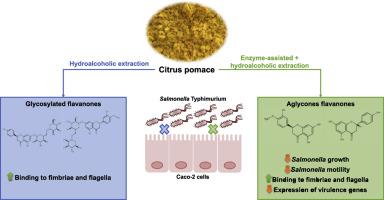当前位置:
X-MOL 学术
›
Food Control
›
论文详情
Our official English website, www.x-mol.net, welcomes your feedback! (Note: you will need to create a separate account there.)
Enzyme-assisted extraction of flavanones from citrus pomace: Obtention of natural compounds with anti-virulence and anti-adhesive effect against Salmonella enterica subsp. enterica serovar Typhimurium
Food Control ( IF 6 ) Pub Date : 2021-02-01 , DOI: 10.1016/j.foodcont.2020.107525 Paula de Paula Menezes Barbosa , Amanda Roggia Ruviaro , Isabela Mateus Martins , Juliana Alves Macedo , Gisèle LaPointe , Gabriela Alves Macedo
Food Control ( IF 6 ) Pub Date : 2021-02-01 , DOI: 10.1016/j.foodcont.2020.107525 Paula de Paula Menezes Barbosa , Amanda Roggia Ruviaro , Isabela Mateus Martins , Juliana Alves Macedo , Gisèle LaPointe , Gabriela Alves Macedo

|
Abstract Food poisoning has been recognized as a global challenge, causing illness in millions of people. Salmonella enterica subsp. enterica serovar Typhimurium is a major foodborne pathogen causing disease in humans by expressing virulence genes to invade the host epithelial cells. Thus, the search for natural compounds with anti-virulence and anti-adhesive effect could help to mitigate Salmonella infection. This study aimed to determine the effect of flavanones on S. Typhimurium virulence and adhesion to Caco-2 cells. Flavanones were obtained from citrus pomace (CP) by enzyme-assisted (CP-E) and conventional hydroalcoholic (CP–H) extraction methods, which produced extracts rich in aglycones and glycosylated flavanones, respectively. CP-E and aglycone standards (naringenin and hesperetin) decreased bacterial growth (25–90%), motility (50–90%), and adhesion to Caco-2 cells (25–50%). CP-H and glycosylated flavanones (naringin and hesperidin) affected only bacterial adhesion (decreased 20–75%). Agglutination assays demonstrated the binding of extracts and pure flavanones to S. Typhimurium adhesion structures. Fimbrial gene expression (fimA and fimZ) was downregulated in the presence of CP-H, CP-E, and aglycones. Both CP extracts decreased the expression of genes associated with cell invasion (hilA, ssrB and sopD). These results suggest that CP extracts and flavanones inhibit S. Typhimurium adhesion by interacting with fimbriae and flagella structures and downregulating fimbrial and virulence genes. CP-E and aglycone flavanones, rarely found in nature, exhibited superior inhibitory effects on bacterial viability, motility, adhesion and virulence gene expression than glycosylated flavanones. The outcomes of this research advance the understanding of how aglycone and glycosylated flavanones impact S. Typhimurium virulence activity and adhesion, contributing to their application as functional food ingredients for the prevention of adhesion, invasion, and the development of this pathogen in the gut.
中文翻译:

从柑橘渣中酶辅助提取黄烷酮:获得对沙门氏菌亚种具有抗毒力和抗粘附作用的天然化合物。鼠伤寒血清型
摘要 食物中毒已被公认为全球性挑战,导致数百万人患病。沙门氏菌肠道亚种。鼠伤寒血清型是一种主要的食源性病原体,通过表达毒力基因侵入宿主上皮细胞而导致人类疾病。因此,寻找具有抗毒力和抗粘连作用的天然化合物有助于减轻沙门氏菌感染。本研究旨在确定黄烷酮对鼠伤寒沙门氏菌毒力和对 Caco-2 细胞粘附的影响。通过酶辅助 (CP-E) 和常规水醇 (CP-H) 提取方法从柑橘渣 (CP) 中提取黄烷酮,分别产生富含苷元和糖基化黄烷酮的提取物。CP-E 和糖苷配基标准品(柚皮素和橙皮素)降低细菌生长 (25–90%)、运动性 (50–90%)、和对 Caco-2 细胞的粘附 (25–50%)。CP-H 和糖基化黄烷酮(柚皮苷和橙皮苷)仅影响细菌粘附(降低 20-75%)。凝集测定表明提取物和纯黄烷酮与鼠伤寒沙门氏菌粘附结构的结合。在 CP-H、CP-E 和苷元存在的情况下,菌毛基因表达(fimA 和 fimZ)被下调。两种 CP 提取物都降低了与细胞侵袭相关的基因(hilA、ssrB 和 sopD)的表达。这些结果表明,CP 提取物和黄烷酮通过与菌毛和鞭毛结构相互作用并下调菌毛和毒力基因来抑制鼠伤寒沙门氏菌的粘附。CP-E 和苷元黄烷酮在自然界中很少发现,与糖基化黄烷酮相比,它们对细菌活力、运动性、粘附和毒力基因表达表现出更好的抑制作用。
更新日期:2021-02-01
中文翻译:

从柑橘渣中酶辅助提取黄烷酮:获得对沙门氏菌亚种具有抗毒力和抗粘附作用的天然化合物。鼠伤寒血清型
摘要 食物中毒已被公认为全球性挑战,导致数百万人患病。沙门氏菌肠道亚种。鼠伤寒血清型是一种主要的食源性病原体,通过表达毒力基因侵入宿主上皮细胞而导致人类疾病。因此,寻找具有抗毒力和抗粘连作用的天然化合物有助于减轻沙门氏菌感染。本研究旨在确定黄烷酮对鼠伤寒沙门氏菌毒力和对 Caco-2 细胞粘附的影响。通过酶辅助 (CP-E) 和常规水醇 (CP-H) 提取方法从柑橘渣 (CP) 中提取黄烷酮,分别产生富含苷元和糖基化黄烷酮的提取物。CP-E 和糖苷配基标准品(柚皮素和橙皮素)降低细菌生长 (25–90%)、运动性 (50–90%)、和对 Caco-2 细胞的粘附 (25–50%)。CP-H 和糖基化黄烷酮(柚皮苷和橙皮苷)仅影响细菌粘附(降低 20-75%)。凝集测定表明提取物和纯黄烷酮与鼠伤寒沙门氏菌粘附结构的结合。在 CP-H、CP-E 和苷元存在的情况下,菌毛基因表达(fimA 和 fimZ)被下调。两种 CP 提取物都降低了与细胞侵袭相关的基因(hilA、ssrB 和 sopD)的表达。这些结果表明,CP 提取物和黄烷酮通过与菌毛和鞭毛结构相互作用并下调菌毛和毒力基因来抑制鼠伤寒沙门氏菌的粘附。CP-E 和苷元黄烷酮在自然界中很少发现,与糖基化黄烷酮相比,它们对细菌活力、运动性、粘附和毒力基因表达表现出更好的抑制作用。



























 京公网安备 11010802027423号
京公网安备 11010802027423号